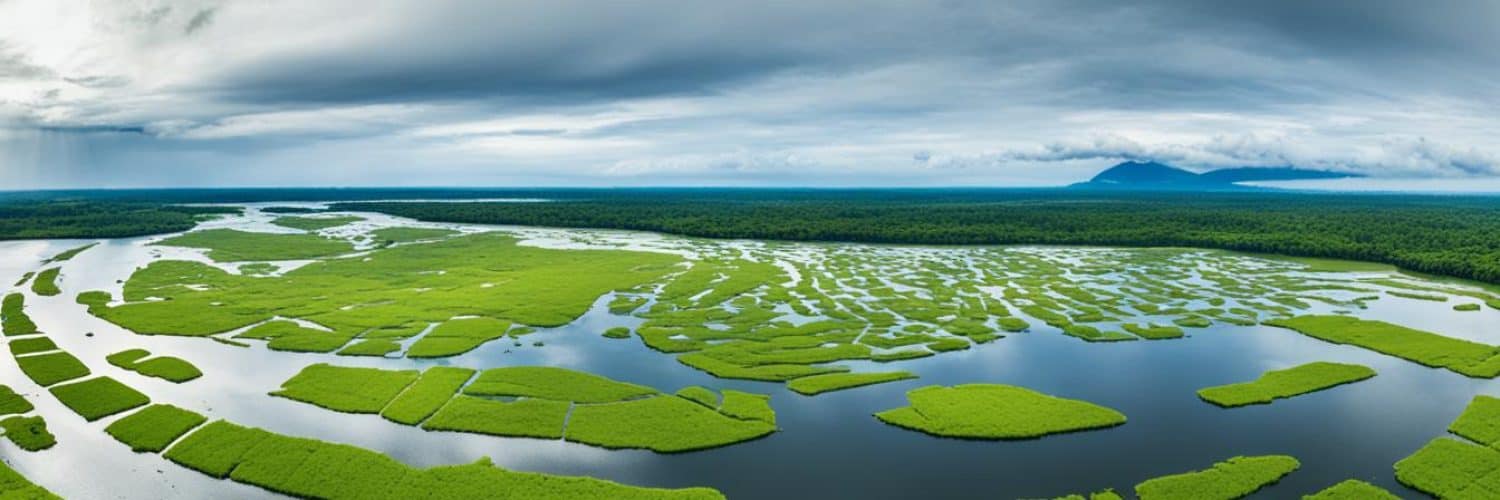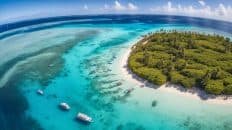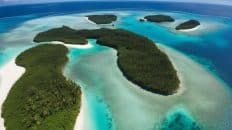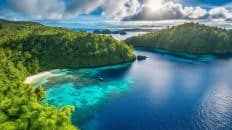Welcome to the Agusan Marsh Wildlife Sanctuary, a hidden gem nestled in Agusan del Sur, Mindanao. Have you ever wondered what makes this sanctuary such a vibrant biodiversity hotspot? Are you curious about the diverse range of species that call this wetland home? Let’s dive into the wonders of Agusan Marsh and uncover the secrets of this remarkable sanctuary.
Key Takeaways:
- Agusan Marsh Wildlife Sanctuary is a protected area in Agusan del Sur, Mindanao.
- The sanctuary is recognized as a Wetland of International Importance.
- It is home to an incredible array of species, including birds, plants, and butterflies.
- The marsh plays a vital role in maintaining ecological balance and supporting migratory birds.
- Conservation efforts are crucial for preserving the biodiversity and cultural heritage of the sanctuary.
The Rich Biodiversity of Agusan Marsh
Agusan Marsh is a biodiversity hotspot, renowned for its wealth of wildlife and diverse ecosystem. The marsh is home to numerous rare and endangered species, such as the fresh water crocodile, salt water crocodile, oriental darter, and Philippine sailfin lizard. These unique creatures find sanctuary within the marsh’s protected environment.
The marsh also serves as a vital habitat for migratory birds, with over 200 species making a stopover during their winter migration from Northern Asia and Siberia. This annual event attracts birdwatchers and nature enthusiasts from around the world, offering them a glimpse of these captivating avian visitors.
The diverse ecosystem of Agusan Marsh provides a haven for various flora and fauna. Within its vast expanse, one can find towering trees, entwining vines, lush grasses, and delicate ferns. This rich diversity of plant life sustains the intricate web of life within the marsh, ensuring the survival of its inhabitants.
“Agusan Marsh is a treasure trove of biodiversity, teeming with rare and endangered species. Its delicate balance of ecosystems supports vibrant wildlife and provides a sanctuary for migratory birds. We must cherish and protect this natural wonder for future generations.”
Wetlands and their Importance in Mindanao
Agusan Marsh, one of Mindanao’s prominent wetlands, plays a vital role in the region’s ecosystem. Wetlands are crucial for maintaining water quality, preventing flooding, and supporting a diverse array of plant and animal species. In the case of Agusan Marsh, it serves as a vital habitat for various wildlife, including migratory birds, and acts as a breeding ground for these feathered visitors. Additionally, the marsh provides a unique and captivating environment for ecotourism, attracting visitors interested in birdwatching, nature photography, and experiencing the natural wonders of these wetlands.
| Importance of Wetlands in Mindanao |
|---|
| 1. Maintain water quality |
| 2. Prevent flooding |
| 3. Support diverse plant and animal species |
Wetlands, like Agusan Marsh, are a vital resource, contributing to the overall environmental health and sustainability of Mindanao. As wetlands continue to face numerous threats globally, it is imperative to understand and appreciate their significance in preserving and conserving our natural heritage.
The Role of Agusan Marsh in Ecotourism
Agusan Marsh provides a one-of-a-kind experience for nature enthusiasts and eco-tourists alike. The abundance of wildlife and unique wetland environment offers endless opportunities for birdwatching, nature photography, and immersing oneself in the beauty of this natural wonder. Visitors can observe migratory birds in their natural habitats and gain a deeper understanding of the intricate connections between wetlands and the diverse species they support.
“Agusan Marsh offers a captivating experience for nature enthusiasts and showcases the importance of wetlands in supporting biodiversity and ecotourism.” – [Your Name]
By promoting responsible ecotourism practices, Agusan Marsh can continue to thrive while raising awareness about the critical role wetlands play in preserving our natural environment.
Through sustainable tourism initiatives, visitors can help contribute to the conservation efforts of Agusan Marsh and ensure the long-term preservation of this remarkable wetland ecosystem.
Conservation Efforts in Agusan Marsh
Several conservation efforts are in place to protect the biodiversity of Agusan Marsh. The area is a designated wildlife sanctuary and is included in the list of Wetlands of International Importance by the Ramsar Convention. The local government, together with organizations and communities, works towards preserving the marsh’s ecosystems and implementing sustainable practices. Measures such as habitat restoration, monitoring of species populations, and educating the public about the importance of conservation contribute to the long-term protection of Agusan Marsh.
Unique Attractions in Agusan Marsh
Agusan Marsh is a treasure trove of unique attractions that are sure to captivate visitors. One of the most popular activities in the marsh is birdwatching, a thrilling experience that allows you to witness the vibrant avian life that calls this wetland home. With over 1,332 species of birds, Agusan Marsh offers an unparalleled birdwatching opportunity.
As you explore the marsh, you’ll have the chance to observe nesting sites and marvel at the majestic herons perched on trees, their graceful movements reflecting the serenity of the wetland. During the winter season, Agusan Marsh becomes a temporary refuge for migratory birds from colder regions, giving you the chance to spot these extraordinary creatures in their natural habitat.
But birdwatching is just the tip of the iceberg. Agusan Marsh’s diverse flora and fauna create a stunning backdrop for various ecotourism activities. Embark on nature tours to immerse yourself in the marsh’s scenic wetland landscapes, or take a boat ride along its intricate network of waterways to discover hidden gems.
For wildlife enthusiasts and photographers, Agusan Marsh offers endless opportunities to capture the beauty of its natural inhabitants. From intricate butterflies fluttering their wings amidst the colorful blooms to elusive crocodiles basking in the sun, every moment spent in Agusan Marsh is a chance to witness the wonders of nature up close and personal.
This unique wetland ecosystem serves as a testament to the importance of conservation and sustainable ecotourism. By preserving Agusan Marsh, we not only protect the incredible biodiversity it harbors but also ensure that future generations can continue to experience its awe-inspiring attractions.
Outdoor Activities in Agusan Marsh:
- Nature tours
- Boat rides
- Wildlife photography
- Birdwatching expeditions
- Exploring wetland landscapes
Notable Wildlife in Agusan Marsh:
“Agusan Marsh is home to a diverse range of wildlife, including various bird species, butterflies, and crocodiles. It provides a haven for migratory birds and is a paradise for birdwatchers and nature enthusiasts.”
Lake Mambagongon and its Avian Refugees
Located in La Paz town within the Agusan Marsh, Lake Mambagongon serves as an important avian refuge. This picturesque lake plays a crucial role in the migration of over 200 bird species from Northern Asia and Siberia during the winter season. These feathered migrants find respite and sustenance in the tranquil waters of Lake Mambagongon, attracting birdwatchers and nature enthusiasts alike.
The diverse bird species that flock to this serene sanctuary contribute to the rich biodiversity of Agusan Marsh, enhancing its status as a haven for avian life. Witnessing the graceful flight and vibrant plumage of these migratory birds is an awe-inspiring experience that highlights the importance of conserving and protecting the natural habitats of Agusan Marsh.
“The beauty of Lake Mambagongon lies not only in its pristine waters but also in the harmonious coexistence of nature and wildlife. It represents a crucial stopover point for migratory birds seeking refuge and sustenance during their arduous journey.”
Notable Bird Species in Lake Mambagongon
| Bird Species | Scientific Name | Conservation Status |
|---|---|---|
| Eastern Yellow Wagtail | Motacilla tschutschensis | Near Threatened |
| Pacific Golden Plover | Pluvialis fulva | Least Concern |
| Siberian Rubythroat | Calliope calliope | Least Concern |
| Greater Sand Plover | Charadrius leschenaultii | Near Threatened |
| Black-faced Spoonbill | Platalea minor | Endangered |
The presence of these and many other bird species in Lake Mambagongon underscores the significance of Agusan Marsh in supporting migratory bird populations and conserving global avian diversity. It is a testament to the interconnectedness of ecosystems and the need for continued conservation efforts to safeguard these precious habitats.
Lake Panlabuhan and its Crocodile Habitat
In the heart of Agusan Marsh lies Lake Panlabuhan, a floodplain lake that serves as a vital habitat for freshwater crocodiles. This picturesque lake, located in Loreto town, is surrounded by a sprawling swamp habitat, spanning across sub-lakes and river channels.
The presence of freshwater crocodiles in Lake Panlabuhan emphasizes the significance of preserving the delicate ecosystem of Agusan Marsh. These crocodiles play a crucial role in the region’s biodiversity and serve as an indicator of a healthy wetland environment.
The conservation of Lake Panlabuhan and its crocodile habitat is essential for ensuring the continued existence of these remarkable creatures and maintaining the overall ecological balance of Agusan Marsh.
| Lake Panlabuhan Facts | |
|---|---|
| Location | Loreto town, Agusan Marsh |
| Habitat | Floodplain lake and swamp |
| Species | Freshwater crocodiles |
| Importance | Contributes to the biodiversity of Agusan Marsh |
Indigenous Communities and their Cultural Practices
Agusan Marsh is not just a sanctuary for diverse wildlife; it is also home to indigenous communities, namely the Manobo people. These communities reside in floating houses on Lake Mambagongon, where they have developed a unique way of life closely connected to the marsh’s ecosystem. The Manobo people have a rich cultural heritage, characterized by their traditional rituals and ceremonies.
One of the most significant practices of the Manobo people is the panagtawag ritual. This ritual is a way for the community to connect with the spirits and seek their guidance and protection. The panagtawag ritual is particularly significant for visitors, as it is offered to ensure their safety during their time in Agusan Marsh.
The panagtawag ritual demonstrates the deep spiritual connection that the Manobo people have with the marsh and its natural resources. It serves as a reminder of the vital role that indigenous communities play in the conservation efforts of Agusan Marsh.
The Manobo people’s cultural practices are deeply intertwined with the preservation of their environment and its biodiversity. They have a profound understanding of the marsh’s resources and the delicate balance needed to sustain them. Through their traditional knowledge and practices, the indigenous communities contribute significantly to the conservation efforts in Agusan Marsh.
The Role of Indigenous Communities in Conservation
The Manobo people actively participate in conservation activities, working alongside government agencies, local communities, and conservation organizations. They have a deep sense of responsibility for the marsh’s natural resources, as these resources are intricately linked to their cultural identity and way of life.
The indigenous communities engage in sustainable practices such as selective fishing and responsible resource extraction. They also actively safeguard the marsh from illegal activities, such as poaching and unlawful logging, which threaten the delicate balance of the ecosystem.
The Manobo people’s knowledge of the marsh’s flora and fauna serves as a vital resource for researchers and conservationists. Their traditional knowledge, passed down through generations, provides valuable insights into the unique biodiversity of Agusan Marsh and informs strategies for its long-term preservation.
Preserving Cultural Heritage and Biodiversity
The preservation of the cultural heritage of indigenous communities within Agusan Marsh is essential for maintaining the harmony between humans and nature. The cultural practices of the Manobo people not only enrich their own lives but also contribute to the overall conservation efforts in the area.
By celebrating and supporting the cultural practices of the indigenous communities, we can ensure the continuity of their traditions and the preservation of Agusan Marsh’s biodiversity. It is through this combined effort of cultural preservation and environmental conservation that Agusan Marsh can thrive as a sanctuary for both wildlife and indigenous cultures.
Inspiring Coexistence
The presence of indigenous communities in Agusan Marsh serves as a reminder of the delicate balance between humans and the environment. Their cultural practices foster a deep respect and connection with nature, reinforcing the importance of sustainable living and conservation efforts.
Through collaboration and education, we can learn from the indigenous communities’ wisdom and incorporate their sustainable practices into our own lives. By embracing their cultural heritage and respecting their traditional knowledge, we can create a future where biodiversity thrives, and indigenous cultures flourish.
Agusan Peatland: A Carbon Sink
Agusan Marsh is home to Agusan Peatland, a valuable carbon sink located in Caimpugan, San Francisco. This swamp ecosystem stores approximately 22.8 million tons of carbon, making it the highest carbon storage capacity in the country.
The Agusan Peatland acts as a natural reservoir for carbon dioxide, playing a crucial role in mitigating climate change. By absorbing and storing carbon, this peatland helps to reduce the amount of greenhouse gases in the atmosphere, contributing to global efforts in addressing climate change.
Protecting and conserving the Agusan Peatland is essential for maintaining the ecological balance of Agusan Marsh and preserving its carbon storage capacity. Sustaining this carbon sink is vital for the long-term health and resilience of the marsh ecosystem.
Agusan Peatland in Caimpugan, San Francisco. (Image source: seowriting.ai)
Mount Magdiwata: A Natural Wonder
Nestled in Agusan del Sur, Mount Magdiwata is a legendary mountain celebrated for its untouched virgin forest and remarkable biodiversity. This awe-inspiring mountain is home to an array of natural wonders, including a series of seven majestic waterfalls and 53 smaller cascades.
Mount Magdiwata’s diverse flora and fauna create a vibrant ecosystem within its enchanting rainforest park. The mountain boasts an abundance of extraordinary trees, such as the iconic lawaan trees, tanguile, and bagrass, adding to its picturesque landscape.
This natural wonder serves as a sanctuary for numerous wildlife species, making it the perfect destination for wildlife enthusiasts and nature lovers. Visitors have the privilege of witnessing deer, monkeys, wild boars, snakes, birds, squirrels, eagles, lizards, and even the elusive tarsiers in their natural habitat.
Mount Magdiwata offers an unparalleled opportunity for nature exploration and hiking. Merging the tranquility of the virgin forest with breathtaking views of the waterfalls, visitors can immerse themselves in the wonders of this picturesque mountain.
| Flora | Fauna |
|---|---|
| Lawaan trees | Deer |
| Tanguile | Monkeys |
| Bagrass | Wild boars |
| Snakes | |
| Birds | |
| Squirrels | |
| Eagles | |
| Lizards | |
| Tarsiers |
Soak in the wonders of Mount Magdiwata’s breathtaking waterfalls and immerse yourself in the vibrant ecosystem of this natural paradise.
The Majestic To-og Trees
The Agusan Marsh and its surrounding area are adorned with the majestic Combretodenton quadrialatum trees, locally known as to-og. These indigenous trees are exclusive to Mindanao and can be seen scattered throughout the marsh, national roads, and the Provincial Capitol Compound in Prosperidad.
Among these remarkable trees stands one of the most prominent to-og trees in San Francisco, proudly holding the title of the world’s third tallest tree. These ancient trees not only contribute to the overall biodiversity of Agusan Marsh but also enhance its natural beauty, offering a stunning spectacle for visitors.
“To-og trees are a symbol of resilience and natural beauty, standing as silent witnesses to the passage of time in Agusan Marsh. Their presence adds a sense of grandeur and tranquility to this remarkable wetland ecosystem.”
Bega Falls: A Natural Wonder
Located in Prosperidad, Bega Falls is a breathtaking natural wonder that forms the core of the Bega River System. This enchanting destination encompasses seven major waterfalls, each offering its own unique beauty and charm. These falls are not only a sight to behold but also serve as a hotspot for biodiversity research.
Surrounded by a protected area within the Ugnop Cave landscape forest reserve, Bega Falls provides a perfect sanctuary for eco-tourism activities. Nature enthusiasts and adventure seekers will find abundant opportunities to immerse themselves in the scenic beauty of the falls and explore the surrounding natural landscapes.
With cascading waters and lush vegetation, Bega Falls creates a picturesque backdrop where visitors can embrace the wonders of nature. Whether it’s admiring the cascades, taking a refreshing dip in the pools, or simply enjoying the tranquil ambiance, Bega Falls promises an unforgettable experience.
“Bega Falls is a hidden gem that showcases the beauty and power of nature. With its cascading waterfalls and lush surroundings, it’s a true paradise for nature lovers.” – Local Travel Enthusiast
Climate in Agusan del Sur
Agusan del Sur, located in Mindanao, experiences a type II climate characterized by a lack of dry season and a distinct wet season with heavy rainfall. Throughout the year, the province receives rainfall, with the highest precipitation occurring from December to January. The climate in Agusan del Sur is heavily influenced by tropical depressions and typhoons that form in the nearby regions.
This unique climate plays a significant role in the formation and sustenance of the wetland ecosystems, including the renowned Agusan Marsh. The consistent rainfall supports the growth of diverse flora and maintains the marsh’s abundant water sources. The weather patterns contribute to the lushness and biodiversity of Agusan Marsh, making it a thriving habitat for numerous plant and animal species.
| Climate Type | Characteristics |
|---|---|
| Type II Climate | No dry season, pronounced wet season with heavy precipitation |
Ecotourism Opportunities in Agusan Marsh
Agusan Marsh, with its diverse wetland ecosystem, rich biodiversity, and unique cultural heritage, provides a range of exciting ecotourism opportunities for visitors. Nature enthusiasts, wildlife photographers, and adventure seekers will find this destination in Mindanao, Philippines, a true paradise. Experience the wonders of Agusan Marsh by exploring the following attractions:
Birdwatching
Agusan Marsh is a haven for birdwatching enthusiasts. Witness hundreds of bird species in their natural habitat, including migratory birds that flock to the marsh during the winter season. From nesting sites to herons perched on trees, the marsh offers an unforgettable avian experience.
Boat Tours
Embark on a boat tour and cruise through the enchanting wetland landscapes of Agusan Marsh. Let the knowledgeable guides take you on an adventure, immersing you in the marsh’s breathtaking beauty. Discover hidden corners, encounter unique wildlife, and capture incredible photographs along the way.
Nature Trails
Explore Agusan Marsh’s nature trails and get up close and personal with its diverse flora and fauna. Immerse yourself in the sights and sounds of the marsh as you hike through lush greenery, surrounded by the symphony of bird calls and the gentle rustling of leaves.
Visits to Indigenous Communities
Connect with the indigenous Manobo communities living in floating houses on Lake Mambagongon. Engage in their rich cultural heritage as you witness traditional rituals and ceremonies. Participate in the panagtawag ritual, known for its significance in ensuring the safety of visitors.
Exploring Scenic Landscapes
Indulge your senses as you take in the stunning landscapes that Agusan Marsh has to offer. Capture the beauty of the marsh with your camera or simply embrace the peace and tranquility of this natural wonder. Witness breathtaking sunsets, stunning reflections on the water, and picturesque vistas at every turn.
| Ecotourism Activities | Description |
|---|---|
| Birdwatching | Observe a diverse range of bird species, including migratory birds, in their natural habitat. |
| Boat Tours | Embark on guided boat tours to explore the marsh’s scenic beauty and encounter unique wildlife. |
| Nature Trails | Explore the marsh’s nature trails, immersing yourself in its diverse flora and fauna. |
| Visits to Indigenous Communities | Connect with the indigenous Manobo communities and experience their rich cultural heritage. |
| Exploring Scenic Landscapes | Capture the stunning landscapes and breathtaking views of Agusan Marsh. |
Local authorities and tourism organizations are committed to promoting sustainable ecotourism practices in Agusan Marsh. By participating in these activities, you contribute to the preservation of the marsh’s natural beauty and cultural heritage, ensuring its conservation for generations to come.
Conservation Challenges in Agusan Marsh
While Agusan Marsh is a remarkable wilderness, it faces numerous challenges that threaten its conservation efforts and the delicate balance of its ecosystems. These challenges include extractive industries, increased population density, and conflicting policies.
One of the major threats to Agusan Marsh is the extraction of natural resources, such as mining and logging. These practices pose a significant risk to the marsh’s diverse ecosystems and the abundant biodiversity it harbors. The disruption caused by resource extraction can lead to habitat destruction and the loss of vital food and nesting grounds for various species.
The growing population in the surrounding areas has also contributed to the challenges faced by Agusan Marsh. Urban sprawl and increased human activity put additional pressure on the wetland environment. As more people settle near the marsh, improper waste management, pollution, and habitat encroachment become pressing concerns.
Furthermore, the presence of conflicting policies and regulations regarding land use and resource management further complicates conservation efforts. The lack of coordination and cooperation among different stakeholders hampers the implementation of effective strategies to protect the marsh’s fragile ecosystems.
“Conservation is a race against time. The growing threats to Agusan Marsh require urgent action to preserve its unparalleled biodiversity,” warns Dr. Maria Lopez, a renowned environmentalist and expert on wetland ecosystems.
“The challenges we face in Agusan Marsh conservation are undoubtedly complex, but they can be overcome through collaborative efforts. It is crucial for government agencies, local communities, and conservation organizations to work together to address these threats and protect this precious natural treasure.”
– Dr. Maria Lopez
Key Challenges Facing Agusan Marsh
| Challenges | Impact |
|---|---|
| Extractive industries (mining and logging) | Loss of habitats, destruction of ecosystems, and reduction in biodiversity |
| Increased population density | Urban sprawl, pollution, habitat encroachment, and improper waste management |
| Conflicting policies and regulations | Obstacles to effective conservation efforts and challenges in implementing protective measures |
Addressing these challenges requires a comprehensive and coordinated approach. Dr. Lopez emphasizes the importance of integrating sustainable practices, enhancing public awareness, and fostering active community engagement. With collective efforts and a commitment to the preservation of Agusan Marsh, its unique biodiversity and rich ecosystems can be safeguarded for future generations to appreciate and cherish.
Conclusion
The Agusan Marsh Wildlife Sanctuary in Agusan del Sur, Mindanao, is a remarkable and biodiverse wetland area. It is a haven for numerous species, including birds, plants, butterflies, and crocodiles. This sanctuary plays a fundamental role in maintaining the delicate ecological balance of the region, providing a vital habitat for migratory birds, and preserving the cultural heritage of the indigenous communities.
Conservation efforts are of utmost importance to protect and sustain the biodiversity of Agusan Marsh. It is essential to safeguard this invaluable ecosystem and promote sustainable eco-tourism practices. Visiting Agusan Marsh offers a unique and unforgettable experience for nature enthusiasts, with its diverse attractions and opportunities for exploring the rich natural landscape in Mindanao.
Agusan Marsh Wildlife Sanctuary stands as a testament to the remarkable biodiversity of Mindanao. Its stunning wetlands and unique wildlife make it a must-visit destination for those seeking to immerse themselves in the wonders of nature and preserve the natural heritage of this remarkable region.


















Add comment